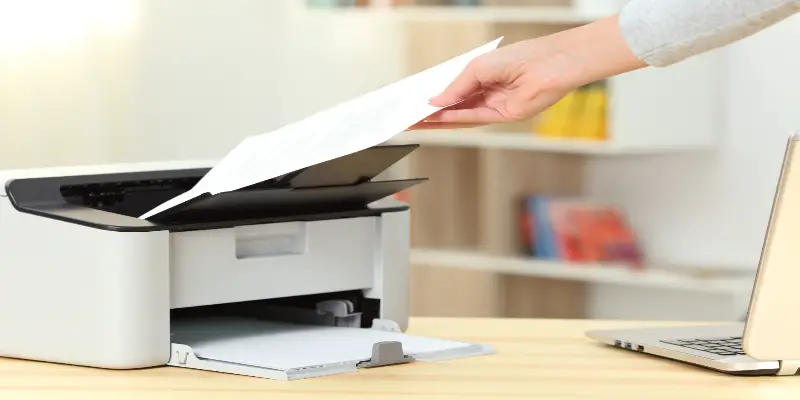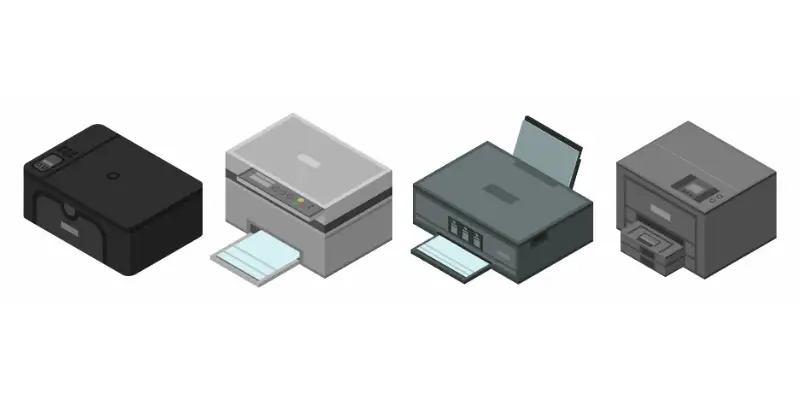Disclaimer: This post may contain affiliate links, meaning we get a small commission if you make a purchase through our links, at no cost to you. For more information, please visit our Disclaimer Page.
The world of technology is rapidly expanding. This encompasses the devices that are necessary for the workplace to carry out daily business functions. The working world is also fast-paced so having a reliable printer is integral. The question is which is better between a WiFi or Bluetooth printer?
With features, WiFi is the better printer however, Bluetooth printers function when the network is down. It is frustrating when the printer won’t print an urgent document. Although this situation can’t always be prevented, choosing the right printer can minimize it from happening.
Choosing the right printer need not be a difficult task. In this article, I will compare the two by discussing their differences. I will explain how they work and discuss different factors such as speed, range, ease of connection, and more.
Table of Contents
How Do Bluetooth Printers Work?
Bluetooth printers work with wireless connectivity. This means that it does not need to be connected to a device using any cables, making it a lot more practical for both home and work environments. How does this work exactly?
A Bluetooth printer transmits data between a device – such as a laptop or PC – to a printing device using low-powered radio frequencies or signals.
How Do Wireless Printers Work?
Wireless printers use a wireless network connection, usually transmitted by a router, to send data from a device to the printer. Unlike a Bluetooth printer, WiFi printers require data to work. These printers can function with any data connection, whether it be a modem, router, or hotspot connection.
Is It Better to Connect by WiFi or Bluetooth?
Since both Bluetooth and WiFi printers are wireless devices, connectivity is an important aspect to consider. Lets discuss factors such as ease of connection, multiple pairing, and the quality of connection.
Ease of Connection
For connecting the printer to other devices, Bluetooth printers are simpler to connect and require fewer components.
WiFi printers depend on a router or network so it needs more components to work. WiFi printers are more complex to connect with and may require technical assistance.
Connecting a Bluetooth Printer
Bluetooth printers are generally easy to connect to. First, users need to make sure to turn on the Bluetooth on their device. Then, set up their adapter by connecting one end to the computer and one to the printing device.
Next, go to Bluetooth devices on the computer and go to Bluetooth devices. Add the device manually for better security. This can be done by selecting Add Device and using the installation wizard.
Another method is to go to the Menu and search for Printers and Faxes. Select Add printer, when the wizard opens click on Bluetooth printer then select the device name when it comes up.
Connecting a WiFi Printer
Before attempting to connect the printer, make sure it is in the WiFi range. Users also need to have their SSID and password. To start the process go to Menu, and then Printers and scanners.
Select Add a printer or scanner then choose the printer name when it appears.
Proceed to install drivers – Windows usually does this automatically. For printers that are more complicated to install, such as requiring multiple office connections, etc. One can get technical assistance.
Multiple Pairing
WiFi printers allow for more connections than a Bluetooth printer. This is because it works using a WiFi network so anyone in the area who is connected to the network can pair with the printer.
Bluetooth printers, on the other hand, do not allow as many connections and are limited.
Which Is Faster Bluetooth or WiFi?
Choosing a wireless option based on speed is dependent on the user’s needs. In some work environments, printing speed is important and some need a connection that can maintain printing speed with large amounts of printouts.
On the other hand, small offices or home environments might require less speed and can do with a printer that can quickly print small batches.
Here I will discuss the difference between the speed of a Bluetooth versus a WiFi connection by looking at the factors that affect each.
Latency
Latency is defined as the delay between a user’s action and a web application’s response to that action. Bluetooth connections usually have a latency of 200ms, whereas WiFi connections have an average latency of 150ms.
The benefit of WiFi, however, is the latency can be further reduced with a better connection and bandwidth.
Bandwidth
If you were wondering what bandwidth refers to exactly, it is the volume of information that can be sent over a connection in a measured amount of time – calculated in megabits per second (Mbps). Even though this differs from the speed, it does affect the printer’s productivity. I’ll compare the bandwidth of these two printers.
Overall Speed
A Bluetooth printer is slower when it comes to its bandwidth. That’s because it is designed to use less power compared to a WiFi printer. The data that it can transfer averages around less than 25Mbps.
A WiFi printer can handle a much higher bandwidth, averaging around 250Mbps. This means they are faster and likely to produce higher-quality prints compared to Bluetooth printers.
What Is the Range of Bluetooth Printer and a WiFi Printer?
The range of a wireless printer refers to the distance of signal transmission. This is an important factor to consider. Users might need a printer that can cover a wide range, such as in an office setting.
Some users only need a home printer or have a small office so the printer can cover a smaller range. I will compare the range between a Bluetooth and WiFi printer here.
The Range of a Bluetooth Printer
Bluetooth connections are generally limited to a smaller radius. It’s great to use one in a small office or as a personal printer.
For Bluetooth devices, like a printer, the range of the Bluetooth connection is approximately 10 meters. This will limit users in a large office space.
The Range of a WiFi Printer
A WiFi printer works by connecting to the WiFi network which is more powerful and allows for a larger connection radius compared to a Bluetooth printer.
WiFi routers operating on the traditional 2.4 GHz band reach up to 46 m indoors.
Comparing Signal Interferences
Both printers use wireless connections so both are prone to signal interferences. However, these interferences vary between the two. I will discuss these here.
Bluetooth Printer
Anyone who has used a Bluetooth device knows that it is prone to experiencing interferences in its connection.
It is not uncommon for someone to experience static while using Bluetooth. This makes Bluetooth printers prone to interferences from other devices.
WiFi Printer
The signal interference experienced with WiFi depends on the quality of the connection. If there is a good connection, then the interference will be less.
The printing process will only be disrupted when the WiFi is down or the signal weakens.
Which Is More Secure WiFi or Bluetooth Printer?
Workplaces or individuals who deal with sensitive information may be concerned about the security of their printers. Since both Bluetooth and WiFi printers are wireless, they are both susceptible to security issues.
Bluetooth Printer
Recent light has been shed on the security issues with Bluetooth connections. Since a Bluetooth printer uses such a connection, it is vulnerable to hackers and cyberattacks. This means that sensitive information is at risk.
Users with Bluetooth printers should use a reliable Firewall, install the latest updates and keep their printer’s firmware updated. One can also ensure a strong Bluetooth password is set up.
WiFi Printer
WiFi-connected printers work over a network making them vulnerable to hackers who are snooping around for sensitive information. There are ways to make these printers more secure.
These methods include configuring your network settings so that your printer only answers commands that come via your network router, using a reliable Firewall, and for businesses who handle sensitive information, consider getting A VPN (Virtual private network)
Which Is Better WiFi or Bluetooth Printer?
Throughout this article, I have discussed many differences between a WiFi and Bluetooth printer. To decide which one is better, one should take the situation or user’s needs into consideration.
Choosing the right printer – Bluetooth or WiFi – depends on many factors. I will summarise the most important ones to consider here.
Cost-Effectiveness
Both Bluetooth and WiFi printers can be cost-effective in their own way. There are different situations where one might be more practical than the other.
If the printer is needed for a big office setting and will need to serve multiple users, then a WiFi printer will be more cost-effective. This is because it is less limited than Bluetooth printers.
Where more than one Bluetooth printer would need to be installed in an area that one WiFi printer can cover.
With that being said, a WiFi printer is more costly for the following reasons. Firstly, it can be more complex to set up, requiring technical support. Secondly, it relies on data to function and it does take up a lot of data.
One would also need to consider a capped WiFi connection to avoid network slowing which may cost more.
Finally, WiFi printers use more power than Bluetooth printers.
For these reasons, a Bluetooth printer will be the more cost-effective option for small areas and where few connections or users are required. This is because it does not require a network connection and uses a low amount of power.
Printing Quality
WiFi printers produce a better printing output. This is because of the way that they compress and transfer data. This makes WiFi printers more suitable for users who need high-quality printouts, whether it be for work or home use.
For smaller office or home settings where high-quality is not needed, Bluetooth printers are a perfect choice. There are Bluetooth printers that have been designed for high-quality printing though.
Practicality
One would want to consider choosing the most practical printer. WiFi printers are practical for larger workspaces because they cover a wider range, allow for multiple users and because of this, only one printer is needed which saves space and is more practical.
For a smaller office or home setting, however, a WiFi printer may be less practical. This is because they tend to be bigger and if there are fewer people in the office or only one device needs to be connected then a Bluetooth printer is probably more suitable. It is also more compact and easier to move around.
The Bottom Line
Choosing the right printer is based on the user’s needs. Where WiFi printers are best suited for large corporations because they are faster, produce better quality prints, are faster, and can connect multiple users.
Bluetooth printers are great for smaller settings or personal use due to their compact size and they are cheaper.



